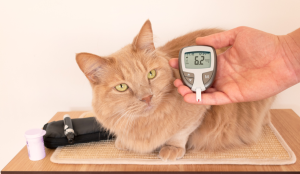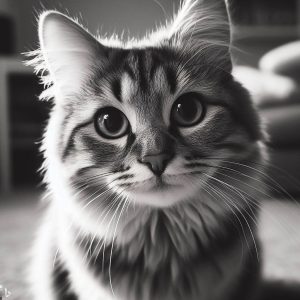Monitoring your diabetic cat’s blood sugar levels is crucial for managing the condition and keeping your furry friend happy and healthy. But specialized pet glucose meters can be expensive. So, can I use my glucose meter for my cat to test your cat’s blood sugar? Let’s find out.
An Overview of Feline Diabetes
Just like humans, cats can develop diabetes when their bodies stop properly regulating blood sugar levels. With feline diabetes (FD), the pancreas fails to produce enough insulin or the body becomes resistant to the insulin it makes. This prevents sugar from being absorbed by cells for energy.
High blood glucose then builds up in the bloodstream. If left uncontrolled, it can lead to various health complications in cats. That’s why regular testing and insulin injections are needed to manage FD.
Common Signs of Feline Diabetes
Watch for these indicators that your cat may have diabetes:
- Increased thirst and urination
- Increased appetite but weight loss
- Fatigue/lethargy
- Dehydration
- Bad breath
- Recurring infections
Diagnosis and Treatment
Only a vet can officially diagnose feline diabetes after examining your cat and running lab tests. Treatment involves:
- Insulin therapy: Daily injections to regulate blood sugar.
- Glucose monitoring: Testing glucose levels to ensure the insulin dosage is correct.
- Dietary changes: Low-carb, high-protein food to stabilize glucose.
- Exercise: Helps improve insulin sensitivity.
- Weight management: Important for overweight diabetic cats.
So monitoring your cat’s blood sugar regularly with a glucose mete
Can I Use My Glucose Meter on My Cat?
The big question is: Can you use a regular human glucose meter to test your diabetic cat’s blood sugar?
The short answer is yes, human glucometers can often double for feline use. But there are some important factors to consider:
Intended Use
Human glucose meters are designed and calibrated for testing human blood samples. They are not officially approved for pets.
However, many cat owners and vets report successfully using human meters “off-label” for cats when proper precautions are followed.
Required Blood Sample Size
Most human glucometers need only a tiny drop of blood – usually 0.3-1 microliter. Feline blood samples are well within this range, allowing human meters to analyze and display the glucose reading.
Measurement Range
Human meters measure glucose levels between ~20-500 mg/dL. Normal cat blood sugar ranges from 70-150 mg/dL. Diabetic cats may reach levels above 250 mg/dL.
So standard consumer meters can accommodate the expected glucose readings for cats.
Accuracy
Human meters are calibrated to accurately measure glucose in human blood. Using them with cat blood may be less precise.
However, they still provide reasonably accurate trends and readings for managing feline diabetes at home when a proper testing technique is followed.
Cost Savings
Specialized pet glucose meters often cost $50-100, plus the cost of test strips. Human meters and strips are significantly cheaper, making regular testing more affordable.
So while not perfect, using human meters “off-label” works reasonably well for many cat owners on a budget. But certain precautions should be taken.
Step-By-Step Guide to Testing Feline Blood Sugar
Once you have the appropriate glucose meter for your cat, follow this process to test their blood sugar levels at home:
1. Have supplies ready
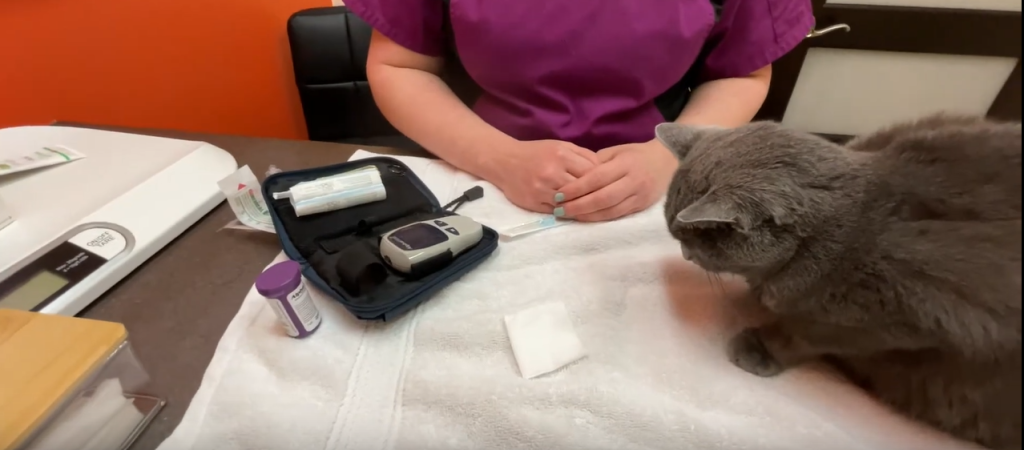
- Glucose meter
- Lancet device + lancets
- Test strips
- Treats
- Log book & pen
2. Clean sampling site
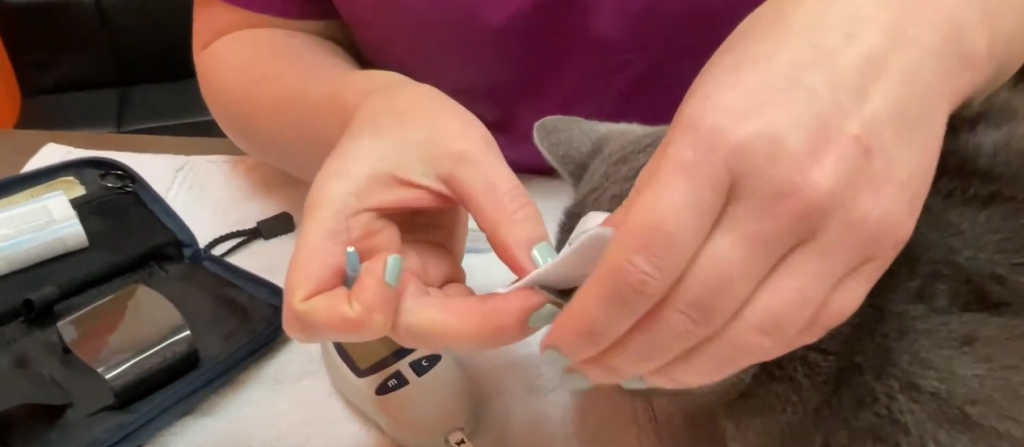
- Gently clean the cat’s ear tip with an alcohol pad and let dry.
3. Prick the ear
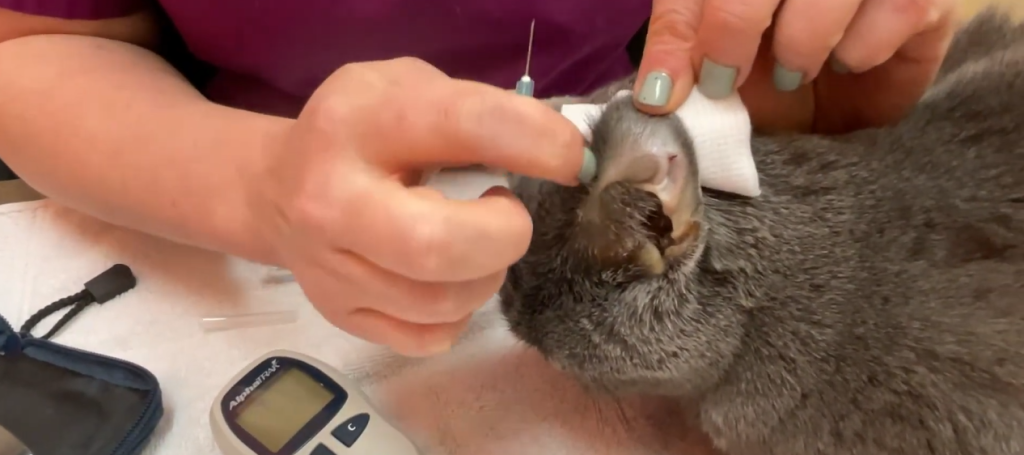
- Twist off the lancet cap and insert the lancet into the lancet device. Adjust depth if needed.
- Position and hold the lancet against the cat’s ear edge and press the button to prick.
4. Get a blood drop
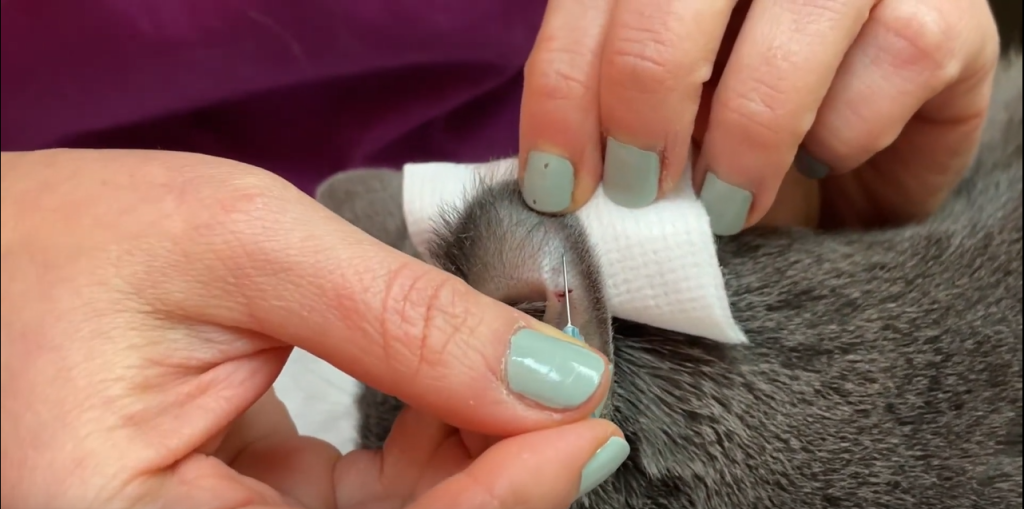
- Gently massage ear to obtain a small drop of blood.
5. Apply sample to test strip
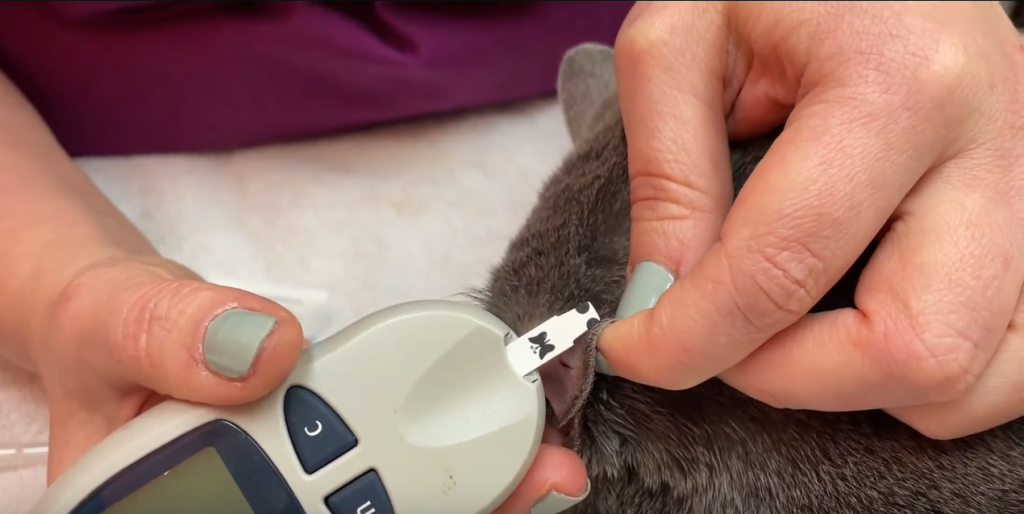
- Insert test strip into meter – it will turn on.
- Touch blood drop to strip’s tip – meter will start reading.
6. Get the reading
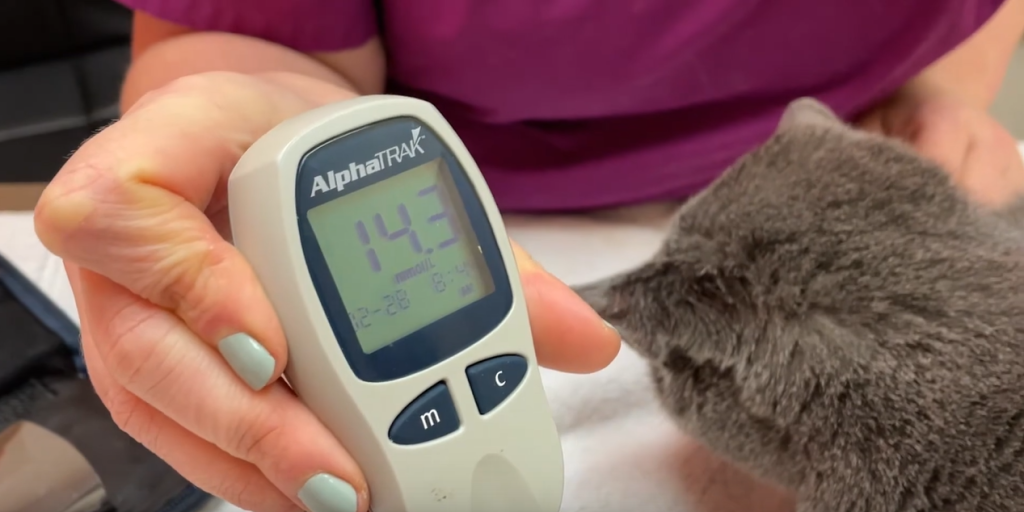
- Meter will display the blood glucose level in mg/dL or mmol/L.
- Note the reading in your log.
7. Reward and clean up
- Reward cat with treats for being still and tolerating the process.
- Dab ear with cotton ball to stop bleeding.
- Used strip and lancet go into a sharps container for disposal.
And you’re done! Be sure to follow your vet’s instructions for timing checks and administering insulin. Consistently monitoring at home provides the data needed to keep your cat healthy.
Tips for Using a Human Meter on Cats
Follow these tips when using your own glucose meter to test your diabetic cat:
Choose the Right Meter
- Opt for a sensitive, high-quality human meter from a reputable brand. More expensive models tend to be more accurate.
- Avoid alternate site testing meters – they aren’t designed for pet use.
- Vet approval – Always consult your vet first and follow their guidelines.
Use Fresh Test Strips
- Test strips expire and can get less accurate over time. Always check the expiration date and use fresh strips.
- Store strips properly to maintain accuracy – cool and dry, not humid.
- Discard strips from any opened vials after 3 months.
Sample from the Ear
- The ear prick method is easiest for cats. Prick the tip of the outer ear flap.
- Paw pads bleed more but are more painful. Consult your vet.
- Never sample from the tail.
Double Check Unusual Readings
- If you get an unusually high or low reading, test again to be sure. Inconsistent results likely mean an issue with the test.
- Confirm unusual levels with your vet promptly – they may indicate a problem.
Keep a Log
- Record your cat’s glucose readings and insulin doses given in a daily log. Share this data with your vet.
- Tracking patterns over time is key for proper regulation.
Calibrate with Vet Tests
- Every 3-6 months, do a simultaneous test at your vet with their professional pet meter and compare.
- If your meter readings are significantly different, its accuracy may be off. Consider replacing it.
By following best practices and your vet’s guidance, you can successfully use a human glucometer to monitor your diabetic cat’s blood sugar at home. However specialized pet meters may be easier to use accurately.
Why Test Your Cat’s Blood Sugar at Home?
Here’s why at-home glucose testing is advised for diabetic cats:
- Better regulate insulin doses – Home meters allow you to check blood sugar anytime and adjust insulin accordingly. Vet visits only provide periodic snapshots.
- Catch highs and lows – Rapidly identify hypo/hyperglycemic episodes before they become emergencies.
- Reduce vet stress – Cats find visits stressful. Home testing reduces trips to the vet.
- More affordable – Home glucose meters are cheaper than paying the vet for frequent testing.
- Spot health changes quickly – Faster swings in feline blood sugar mean you need to monitor it more closely.
So home glucose monitoring provides cat owners with the data needed to keep their cats’ diabetes well-controlled. Now let’s see if human meters can be used.
Are There Pet Glucose Meters Specifically for Cats?

While regular human meters work in many cases, there are also glucose meters designed just for pets. Here are some benefits of specialized feline diabetes testing kits:
- Improved accuracy – Pet meters are calibrated specifically for cat or dog blood. Results are more precise.
- Smaller blood volume – They need only a microscopic 0.3-0.6 microliter sample. Easier for cats.
- Auto-coding – There are no test strips or codes to enter. Less hassle.
- Lancet options – Come with smaller gauge lancets to minimize pain.
- Vet recommendation – Many vets prefer meter kits made for pets.
However, the trade-off is they often cost 2-4 times more than human meters. Some popular options include:
- AlphaTrak Feline Glucose Meter – $119 with 50 strips
- PetGLUCO+ Meter – $79 with 25 strips
- ForaCare Pet Meter – $50 with 50 strips
Your vet can recommend a suitable feline diabetes testing kit. Cost may determine if a human meter is more practical for regular use.
What’s a Normal Blood Sugar Range for Cats?
So what glucose result on the meter is considered normal or abnormal for cats?
According to the Cornell University College of Veterinary Medicine, here are the target feline blood sugar ranges to aim for when testing:
- Non-diabetic cats: 90-150 mg/dL
- Well-managed diabetic cats: 100-250 mg/dL
- Ideal for diabetic cats: 100-200 mg/dL
Talk to your vet about your cat’s optimal target range. Regular testing lets you see when their blood sugar drifts too high or low so you can take action.
Signs your cat’s diabetes may not be controlled include:
- Glucose over 250 mg/dL
- Sudden glucose spikes or drops
- Hypoglycemic episodes under 70 mg/dL
Consult your vet promptly if your at-home meter shows these levels. Their treatment plan may need adjustment.
What If My Cat’s Blood Sugar Is High?
Consistently high glucose levels indicated by at-home testing likely means your cat’s diabetes is not well-regulated on its current insulin regimen.
Some steps to bring their blood sugar down:
- Give insulin as prescribed – don’t change dosage without vet guidance.
- Request a dose increase from your vet if needed.
- Ensure proper injection technique – your vet can advise.
- Feed a low-carb, high-protein diet.
- Increase exercise and playtime.
- Consider prescription diets or oral medications.
- Rule out infections and other illness raising glucose.
- Identify and reduce stress factors.
- Retest in 2-4 hours and call your vet if still high.
Getting your cat’s blood sugar down to a normal range is key for their long-term health and happiness.
What If My Cat’s Blood Sugar Is Low?
On the other end, a low blood glucose reading on your meter may indicate hypoglycemia – a dangerous insulin overdose. Watch for symptoms like:
- Lethargy, weakness
- Seizures
- Hunger, vomiting
- Fast heartbeat
- Shaking, unsteadiness
For mild lows:
- Feed honey, maple syrup or nutrimental gel.
- Retest in 15 minutes.
- Call your vet if it drops further or symptoms worsen.
For severe hypoglycemic emergencies:
- Rub honey, corn syrup or condensed milk on gums.
- Rush to an emergency vet immediately – it’s life-threatening.
- The cat may need dextrose IV, glucagon injection or hospitalization.
Prevent dangerous low blood sugar episodes in the future by:
- Adjusting insulin dosage as directed by your vet.
- Avoiding missed meals.
- Monitoring glucose more frequently.
- Discuss treatment options with your vet.
Long-Term Management of Feline Diabetes
While challenging, feline diabetes can be managed with commitment and care from pet owners. Be sure to:
- Check blood sugar regularly with home meter – aim for 2-3x daily.
- Give insulin precisely as prescribed.
- Monitor diet – feed high protein, low carb food.
- Encourage exercise – it helps stabilize blood sugar.
- Maintain weight – obese cats have more issues regulating glucose.
- Reduce stress – it exacerbates symptoms.
- See your vet for checkups every 3-6 months.
- Watch for issues like infections, arthritis, dental disease.
- Log all data – glucose readings, insulin doses, diet, etc.
Cats can enjoy many happy years with proper management of diabetes. Consistent at-home testing enables you to catch any fluctuations and work with your vet to tweak treatment accordingly.
Common Questions about Glucose Testing in Cats
Here are answers to some frequently asked questions about monitoring blood sugar in diabetic cats:
How often should I test my cat’s blood sugar?
- Initial regulation: 2-3x daily
- Well regulated: 2x daily
- If issues arise: 3-4x daily
Follow your vet’s advice on the ideal frequency for your cat.
What time of day is best to test cat glucose?
- Before insulin shots
- Any time your cat seems off
- Right before meals
- 2 hours after eating
Aim to establish trends at consistent times.
Does cat glucose testing hurt them?
Cats may dislike the process, but the ear prick causes minimal brief pain. Reward with treats after to ease anxiety. Regular handling/restraint helps them better tolerate testing.
Can I test cat glucose with urine or saliva?
No – only blood glucose testing is reliable enough for managing feline diabetes. Urine and saliva are not recommended.
How do I introduce my cat to home glucose testing?
Start slowly – offer treats while handling their ears, pressing the “pricker” against their ear but not actually triggering it at first. Over multiple short sessions, build up to pricking their ear and testing their blood glucose. Patience prevents trauma.
Consistent at-home blood sugar testing, along with insulin therapy, diet regulation, and exercise gives diabetic cats their best shot at a happy life. Work closely with your vet and use an accurate meter – human or pet – to stay on top of your cat’s FD. Proper management and care helps diabetic cats thrive!

